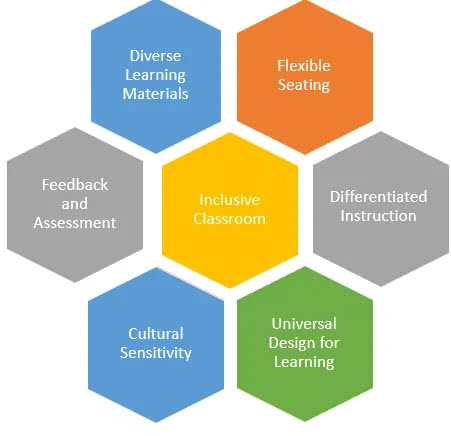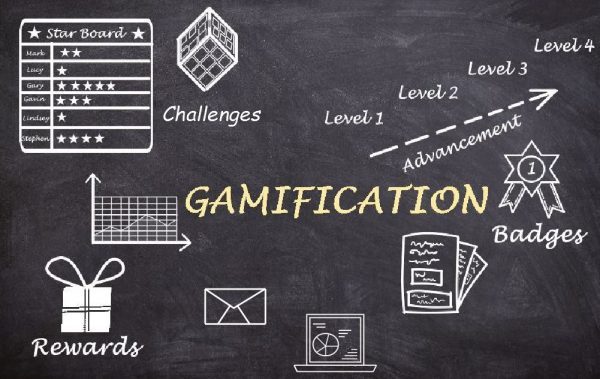Diversity and Inclusion are the next aspects we will examine in Social Emotional Learning. Learning about who we are culturally as individuals, as a learner, and as a contributor to the classroom, school, and community can build the path to our own empowerment. By implementing supporting Diversity and Inclusion, teachers can create a safe learning environment and improve academics. Explore these four cards to discover valuable practices that impact student-teacher relationships.
Differentiation
Both intern teachers and student teachers can engage with the “Diversity and Inclusion” Playbook based on their own teaching and learning experiences. Intern teachers, what SEL strategies are you currently implementing? Student teachers, where do you want to begin with strategies to support Diversity and Inclusion in your classroom?
Considerations
Through your Playbook learning, how can you reflect on ways in which you can bring the whole child into classroom learning experiences? How will you create an environment that is safe, nurturing, and empowering for each child that enters your room?
Card #1: Self identity
SEL in Action: List 3 SEL strategies you heard the children suggest in the video “Dear Teacher: Heartfelt Advice for Teachers from Students.”
- Let the students be able to move around in their seats while learning.
- Let the students look around while you are teaching.
- Ask the students what their brain needs to learn right now.
SEL Snapshot: Read about the purpose and intention of the Start Student activity. Describe the process you will use with your students (identify your grade level) to celebrate the uniqueness and likeness of each child’s identity.
For 10th-grade students, the activity can be adapted to be more age-appropriate and delve deeper into their evolving identities. Here’s the process I would employ:
- Introduce the concept. We would begin by discussing the concept of identity. This could include definitions, how identities are formed, and the different components of identity (cultural, racial, gender, etc.).
- The Star Student Interview. Each day will feature a different “Star Student.” In the high school version, reporters can ask more open-ended questions such as, “What’s a tradition that’s important to your family?”, “What hobbies or activities make you feel most like yourself?”, How has your identity shaped your experiences?”, What’s a challenge or success you’ve faced that you believe is tied to your identity?” etc. Instead of scribing, I might consider video recording or audio recording of the interview and sharing it with the class to be kept as a memento.
- Class Reflections. After each interview, I would hold a class discussion on the commonalities and differences observed. I would encourage the students to share how they relate to the Star Student’s experiences and how they differ from their own. Students would then write a short reflection on what they learned from the day’s Star Student, either in the form of a news article or a more personal journal entry.
- Reflection Compilation. I would create a digital portfolio where all students could access each article and reflection using various platforms where students can add pictures, videos, or other multimedia elements to enhance their reflections.
- Celebrate Uniqueness and Likeness. Once everyone has had a turn as a Star Student, I would have students create a collage or mural showcasing the diverse identities of their classmates. The activity would end with a discussion on the importance of recognizing individual identities, respecting differences, and the value of having a diverse community.
Think About It: After viewing the second and third videos in the SEL in Action section, what practices will you apply to provide opportunities for students to examine their self-identity as a person, as a learner, and as a contributor to the classroom, school, and community?
Some of the practices I can apply to provide students the opportunity to examine their self-identity as a person include:
- Personal identity journals that encourage students to reflect on experiences, beliefs, values, and aspirations.
- Learning style assessments to help students understand how they learn best and strategize ways to use their strengths and work on their weaknesses.
- Allocate time for regular classroom meetings where students can discuss their roles in the class, share concerns, and celebrate achievements.
- Design projects that encourage students to identify issues in the community and come up with solutions.
Act on It: Set an attainable goal for yourself that articulates a vision you have for building classroom community.
Within the next academic semester, I want to create a classroom community where every student feels a strong sense of belonging and is empowered to contribute to the learning environment actively. I can do this by implementing a weekly collaborative activity and monthly student-led classroom discussions.
Achieving this goal would create a classroom atmosphere where students feel heard, understood, and integral to the collective learning experience, ultimately building a strong and supportive classroom community.
Card #2: Culturally and Responsive Teaching
SEL in Action: Watch the Culturally Responsive Learning at the San Francisco Public Library video. Describe the five components of an Academic Mindset?
In reviewing the video, there were only 4 components listed as components of an academic mindset. These were:
- I belong to this academic community. This entails a strong sense of academic belonging where the students see themselves as members of both the social and intellectual communities.
- I can succeed at this. This is the degree to which students feel they are good at a particular subject or kind of task and is strongly associated with academic perseverance.
- My ability and competence grow with my effort. This is the likeliness of students to perceive academic challenges and mistakes as opportunities to learn new things and develop their brains, i.e., the degree to which they have a growth mindset.
- This work has value for me. This is the intrinsic value students place on academic tasks and topics that have some connection to their lives, interests, or educational pursuits.
Think About It: After viewing the video, reading the quotes, and reviewing the snapshot, what are the core SEL values you will apply in your classroom to recognize and address culture and identity through your teaching and your student’s learning.
By integrating Social-Emotional Learning (SEL) into my future teaching approach, I’ll emphasize self-awareness, helping students dive deeper into their emotions, values, and cultural experiences. Self-management techniques will be introduced, so students can handle cultural misunderstandings and navigate differences effectively. As I weave in diverse cultural perspectives, I’ll ensure my students develop empathy and perspective-taking skills. My goal is to push students to communicate in ways that respect diverse backgrounds by advocating for strong relationship-building skills. Whenever I facilitate decision-making activities, I’ll emphasize the importance of considering ethical and broader community implications. With every lesson plan, I’ll make sure different cultural narratives are represented, and every student feels valued. Finally, I’ll promote a growth mindset, emphasizing that cultural differences can be a learning opportunity. This will help me establish a classroom where culture and identity will be recognized and celebrated.
Think About It: Think about your answers to the previous questions posed in the “Think About It” section. Identify strategies you might use in your own classroom and develop a plan of action using the provided downloadable form. Add to Your Personal Action Plan.
Your Action Plan
Now you will write your own next steps! Think about your answers to the previous questions posed in the “Think About It” section. Identify strategies you might use in your own classroom and develop a plan of action using the provided downloadable form. Add to Your Personal Action Plan in this table.
Goal: I will build cultural competency in my classroom by…
Classroom Community: (e.g., using real-world projects)
- Integrating real-world projects that represent diverse cultures and perspectives.
- Facilitating bi-weekly classroom discussions on diverse cultural topics, allowing students to share personal experiences and learn from one another.
My Own Actions: (e.g., reflecting on my own cultural identity and the impact it has on my teaching practices)
- Dedicating time each month to reflect on my own cultural identity and its influence on my teaching practices.
- Holding monthly sessions where students can express any concerns or feedback related to cultural representation and respect in the classroom.
School Community: (e.g., seeking and giving transparent feedback from colleagues)
- Seeking feedback from colleagues on my teaching methods, with a focus on cultural inclusivity.
- Collaborating with at least three other teachers to share resources, activities, and strategies for promoting cultural competency in our classrooms.
Goal: I will foster a strong sense of community and mutual respect in my classroom by…
Classroom Community: (e.g., using real-world projects)
- Introducing a peer-to-peer mentorship program, pairing older or more experienced students with newer ones.
- Implementing weekly “community circle” sessions where students can share personal stories, discuss concerns, or celebrate achievements.
My Own Actions: (e.g., reflecting on my own cultural identity and the impact it has on my teaching practices)
- Establishing an open-door policy, setting aside designated hours each week where students can approach me with any concerns, feedback, or questions.
- Administering monthly anonymous feedback surveys to students, focusing on classroom dynamics and the sense of community.
School Community: (e.g., seeking and giving transparent feedback from colleagues)
- Working with other teachers to plan joint activities or projects that allow different classes or grade levels to collaborate.
- Organizing quarterly parent-teacher meetings, including sessions where parents can share insights, concerns, or suggestions related to the classroom community.
Goal: I will enhance the development of critical thinking and problem-solving skills in my students by…
Classroom Community: (e.g., using real-world projects)
- Introducing monthly classroom debates on relevant and challenging topics.
- Incorporating problem-based learning activities into the curriculum, presenting students with real-world challenges to solve.
My Own Actions: (e.g., reflecting on my own cultural identity and the impact it has on my teaching practices)
- Curating teaching materials from various sources that present diverse perspectives and complexities.
- Creating a system for students to give feedback on which classroom activities and discussions they found most intellectually challenging and stimulating.
School Community: (e.g., seeking and giving transparent feedback from colleagues)
- Collaborating with other teachers to design interdisciplinary projects that require students to apply critical thinking across multiple subjects.
- Proposing or participating in organizing school-wide challenges or competitions that emphasize critical thinking, such as logic puzzles, debates, or innovation fairs.
Goal: I will cultivate an environment of emotional intelligence and resilience in my students by…
Classroom Community: (e.g., using real-world projects)
- Introducing a weekly “emotion check-in” using an emotion wheel, where students identify and discuss their feelings.
- Incorporating bi-weekly role-playing activities where students navigate various interpersonal challenges.
My Own Actions: (e.g., reflecting on my own cultural identity and the impact it has on my teaching practices)
- Establishing monthly open dialogue sessions where students can discuss personal challenges, achievements, and growth moments in a safe and supportive setting.
- Soliciting feedback every semester regarding the emotional climate of the classroom, making necessary adjustments based on student input.
School Community: (e.g., seeking and giving transparent feedback from colleagues)
- Collaborating with fellow educators to organize inter-class team-building activities at least once a semester, promoting trust and understanding between different student groups.
- Proposing or supporting school-wide well-being initiatives, such as mindfulness sessions or stress-relief workshops.
Goal: I will prioritize digital literacy and responsible technology use in my classroom by …
Classroom Community: (e.g., using real-world projects)
- Conducting bi-monthly workshops on digital etiquette, highlighting topics like online communication norms.
- Dedicating class sessions every month to teach students how to research effectively and discern credible sources from unreliable ones.
My Own Actions: (e.g., reflecting on my own cultural identity and the impact it has on my teaching practices)
- Subscribing to e-learning and digital education forums, ensuring I’m updated on the latest digital tools, trends, and potential risks.
- Consistently demonstrating responsible digital behavior in my teaching methods, ensuring that any digital resources I use or recommend adhere to best practices.
School Community: (e.g., seeking and giving transparent feedback from colleagues)
- Collaborating with fellow teachers to design at least one interdisciplinary digital project per semester, allowing students to use technology across various subjects.
- Organizing digital literacy workshops for parents at least once a year, offering them insights and guidance on guiding their children’s online behavior.
Card #3: Building the Classroom Community to Increase Understanding on Diversity and Inclusion of All Students
Intro: Watch the video on How Schools Can Improve Diversity Equity and Inclusion Practices. What practices do you think schools should engage in to create a culture of respect and trust and prepares students to learn?
All stakeholders need to communicate clearly and openly in schools to foster a culture of respect, trust, and readiness to learn. In lieu of punitive approaches, restorative justice practices can foster empathy and understanding. Schools should adopt an inclusive curriculum, celebrating diverse perspectives and offering cultural competency training. Students can build community and trust by participating in decision-making and introducing peer mediation. By incorporating socio-emotional learning, students can develop emotional intelligence, while flexible learning environments can cater to different learning styles. Finally, educators must consistently model respect, with robust anti-bullying policies and feedback mechanisms in place to ensure a safe and nurturing learning atmosphere.
SEL in Action: After watching the videos Using Diversity to Build a Culture of Belonging and Building a Community in the Classroom; List 3 SEL strategies you observed.
- Students participate in creating every classroom’s code of conduct or social contract.
- In one class, a teacher encourages kids to contribute to improving the culture by acknowledging and celebrating moments of kindness with a pom-pom jar.
- Many teachers select books and build units that relate to students’ languages and cultures.
Think About It: What does an inclusive classroom look like? Brainstorm and draw a concept map with the elements.

Act on It: Think about the intentional strategies listed in “Plan It”. List three strategies that are appropriate for your grade level and subject area.
- Culturally Responsive Math Problems and Scenarios
- Math Autobiography Projects or “Dear Math” Letters
- Collaborative Problem-Solving with Rotating Roles
Card #4: Title: The Power of Inclusive Education
SEL in Action: Watch the video and provide a 3-5 sentence summary of your learning and how it connects to your SEL comprehension so far.
Inclusion is about belonging. This is accomplished through instruction that is planned and intentional. We all benefit from good instruction that helps learners feel more confident and competent.
Think About It: Answer each of the guided reflection questions in this section.
After viewing the videos, reading the quotes, and reviewing the graphics, what are the core SEL values you will apply in your classroom to support diverse learners and encourage higher levels of connection among all students?
To foster an environment where diverse learners feel supported and connected, I will prioritize core Social and Emotional Learning (SEL) values. Emphasizing self-awareness and self-management, students will learn how to recognize their emotions and regulate their behavior. Through social awareness and relationship skills, students will be taught empathy and effective communication, bridging the gap between diverse backgrounds. Responsible decision-making will be emphasized, ensuring choices are based on respect and understanding. To ensure that each student feels heard and understood, a growth mindset will be instilled; challenges will be seen as opportunities, and active listening will be promoted. With these intertwined SEL values, the classroom will become a place where all students feel valued and connected, regardless of their background.
Act on It: List your action plan in the box below, following the directions listed on this card.
Professional Development for Teachers: Exploring Inclusion and Learning about Differences
Host a World Café-modeled event for educator professional development. The World Café process draws from seven integrated design principles. The World Café methodology is a simple, effective, and flexible format for hosting large group dialogue. Each element of the method has a specific purpose and corresponds to one or more of the design principles. Click here for more information on how to hold a World Café. Download a quick reference guide on how to host a World Café (Café-To-Go-Reference Guide, 2015).
- Setting the Context:
- Purpose: Engage educators in a dialogue to deepen their understanding of inclusion and celebrate the diverse perspectives and experiences that enrich the learning environment.
2. Creating a Hospitable Space:
- Venue: A spacious room with round tables, each accommodating 4-5 participants. Decorations will include diverse and inclusive imagery.
- Ambiance: Soft background music will be played, and there will be adequate lighting. A variety of international snacks will be provided.
3. Exploring Questions that Matter:
- Round 1: “What does ‘inclusion’ mean to you personally and in your professional practice?”
- Round 2: “Share an experience where you felt included/excluded. What made the difference?”
- Round 3: “How can we celebrate and learn from our students’ diverse backgrounds and experiences?”
4. Encouraging Each Person’s Contribution:
- Facilitation: Each round will begin by emphasizing the importance of listening and valuing each voice. A timer will be used to ensure everyone gets an equal chance to speak.
5. Cross-Pollinating & Connecting Diverse Perspectives:
- After each round, participants (except for the table host) will move to a new table.
- Table hosts will briefly summarize the previous discussion for the new members.
6. Listening for Patterns & Sharing Insights:
- Group Reflection: After the table discussions, everyone will gather for a full-group reflection. Facilitators or volunteers will note patterns, insights, and shared themes on a large board or screen.
7. Harvesting & Moving Forward:
- Action Steps: Based on the dialogues, we will brainstorm actionable steps that will promote inclusion and celebrate differences in the educational setting.
- Feedback Loop: An anonymous feedback tool (like Mentimeter) will be used to gauge participants’ key takeaways and areas for further exploration.
Assignment Grade: 30/30



